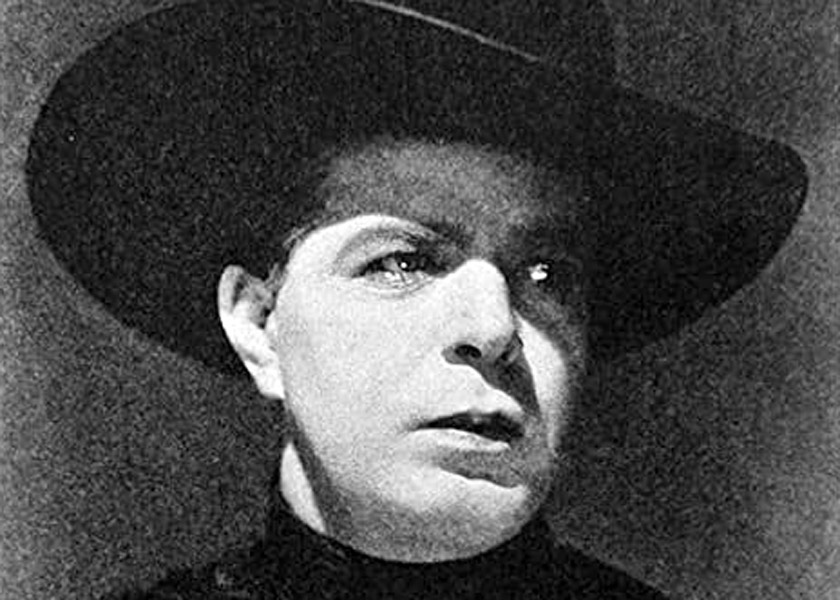Career
Hoot Gibson learned horsemanship in his native Nebraska. As a teenager he was a
member of Col. Stanley’s Congress of Rough Riders and spent a year in Australia on
the rodeo and vaudeville circuit. In 1912 at age twenty, he won the title of
Cowboy Champion of the World as a bronco buster
at the Pendelton Roundup.
Gibson’s film career began in 1910 with a few films for the Biograph Company interspersed among rodeo competitions. In 1914 he was a stuntman for the serial The Hazards of Helen, doubling the serial’s star Helen Holmes. His stunts included fights on trains and transfers from a train to a horse. He had supporting roles in numerous Western short films, including playing the villain in Knights of the Range (1916) opposite popular western star Harry Carey. He appeared in three of the Westerns made by Carey and director John Ford in 1917: Straight Shooting, The Secret Man, and A Marked Man. Hoot’s starring career at Universal Studios was launched in two films directed by Ford, Action (1921) and Sure Fire (1921). In these films, Hoot plays a wandering cowboy who rescues the pretty young co-star from outlaws.
Hoot became a popular western star for Universal. Film titles such as Ridin’ Wild (1922), Thrill Chaser (1923), Hit and Run (1924), Hurricane Kid (1925), and Galloping Fury (1927) guaranteed Hoot’s fans five reels of action and fun. Hoot’s easygoing approach gave his films a lighthearted tone. A deft comedian, he featured as much comedy as drama.
As talkies arrived, Hoot continued as a Western star, but with lower budget
producers such as M.H. Hoffman Inc. (distrubuted on a state rights basis by Allied
Pictures Corporation) and Walker Futter Productions (Diversion Pictures). In 1935,
Hoot co-starred with Harry Carey in Powdersmoke Range, advertised by
RKO as the Barnum and Bailey of Westerns
(whatever that means). The cast
list of this all star
(B western stars) film included Bob Steele, Guinn
Big Boy
Williams, Tom Tyler, William Farnum, and other Westerners from the
silent era. In 1937 at Republic, he made a serial,
The Painted Stallion, in support of new cowboy star
Ray Corrigan.
An aging Hoot retained his fine horsemanship and comic flair, but fan interest had moved to the new singing cowboys, especially Gene Autry and Roy Rogers. Hoot’s Westerns had lost their appeal. In the late thirties, out of movies, Hoot toured with circuses and appeared at rodeos and fairs.
In 1943, after seven years off the screen, Hoot returned in the Trail Blazer series at Monogram Studios. In these Westerns, Marshall Hoot Gibson, initially co-starred with Ken Maynard and later with Bob Steele and Chief Thundercloud, upholds the law and captures outlaws and crooked businessmen threatening the lives and property of innocent citizens. Hoot made eleven Trail Blazer films; the last was Trigger Law (1944). John Ford brought Hoot back for a cameo role in The Horse Soldiers (1959). His last screen appearance was as a sheriff’s deputy in Ocean’s Eleven (1960), another cameo.
Personal Life
Hoot Gibson, born Edmund Richard Gibson, learned to ride in his native Nebraska. By his teenage years, he was a professional bronco buster, touring Australia on the rodeo and vaudeville circuit. His award, a hand-carved, silver-embossed saddle, for winning the Cowboy Championship of the World at the 1912 Pendleton Roundup (Oregon) was a prized possession.
As a well-paid star at Universal, Hoot made, and rapidly spent, a fortune. During his movie making years, he owned a ranch in Saugus, California, where he held an annual rodeo. After his retirement from movies, he left Hollywood for Las Vegas. He owned a divorce ranch, the D-4-C Ranch, where women seeking relatively rapid divorces lived during the weeks of Nevada residency required for obtaining a divorce. After he sold the ranch, Hoot was a host at the Last Frontier Hotel.
Numerous mishaps, in the rodeo, as a stuntman, as a star, and in a plane crash,
never daunted Hoot. He would recount his hard landings with a grin. He bought cars
and airplanes and enjoyed racing them. In 1933, Hoot was seriously injured in an
air crash while piloting his plane in the National Air Races. He was racing fellow
cowboy star Ken Maynard when the accident occurred. Hoot spent months recuperating
from his numerous broken bones. In his later years, he limped on a
game leg,
the result of a hard fall from a horse during one of his rodeo
appearances.
Hoot was married four times. His third wife was actress Sally Eilers with whom he made three films. His fourth marriage, in 1942, to Dorothea Dunston lasted until his death.
Career Consideration
Hoot Gibson was a colorful figure, a light-hearted, fun-loving personality on screen and off. Hoot’s cheerful westerns included a significant amount of comedy. His mild, peaceful character rarely carried a gun. As an expert horseman, Hoot was always impressive on a galloping horse.
Further Reading

